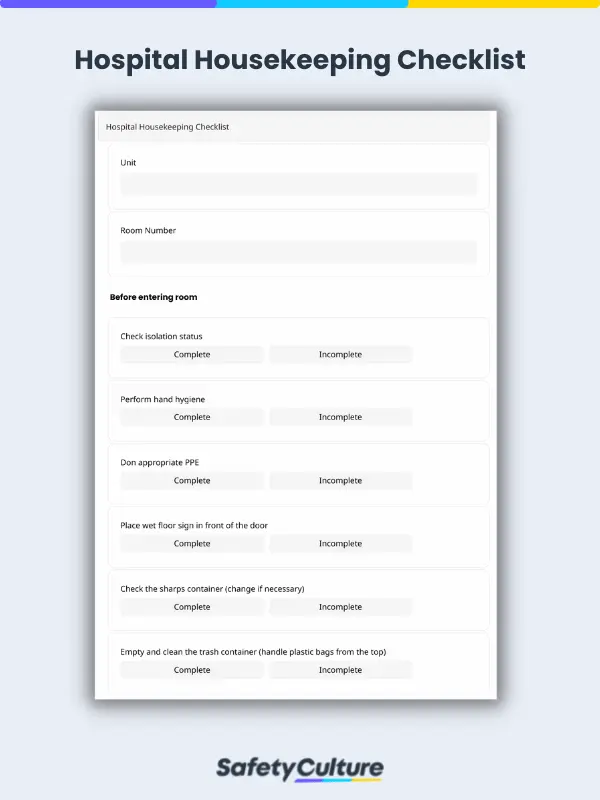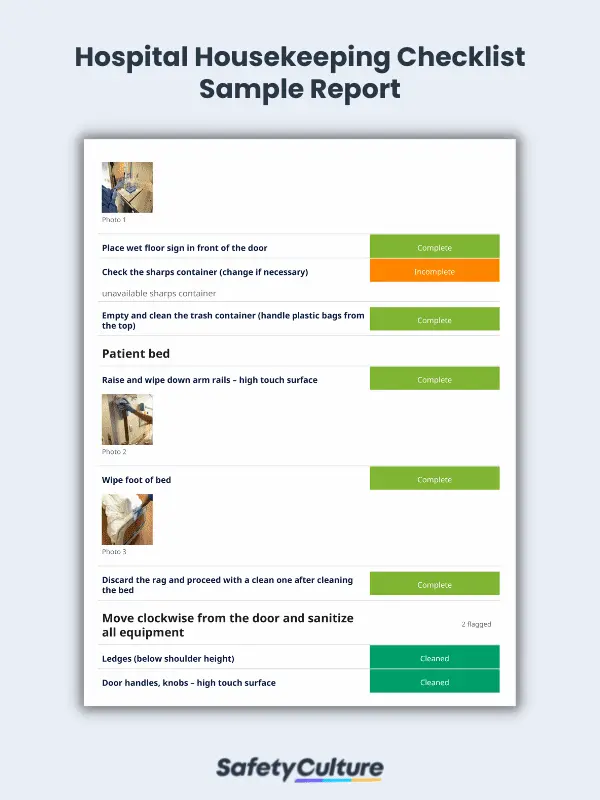What is a Hospital Housekeeping Checklist?
A hospital housekeeping checklist is a tool used to standardize cleaning procedures in hospital settings. It outlines all cleaning tasks in a single file to make it easier for hospital housekeepers to efficiently perform their housekeeping duties according to established protocols. With proper housekeeping, hospitals can avoid the spread of infectious diseases and create a sanitized environment for patients and staff.
What is Hospital Housekeeping?
Hospital housekeeping, also known as hospital cleaning, aims to sustain a sterile environment in all areas of the hospital by implementing high standards of cleanliness. Good hospital housekeeping practices, such as terminal cleaning of high-risk areas and routine cleaning of high-touch surfaces, can prevent the spread of hospital-acquired infections and ensure the safety of both hospital personnel and patients.
Why Use Housekeeping Checklists for Hospitals?
Hospital housekeepers and hospital housekeeping officers should take advantage of mobile-ready hospital housekeeping checklists to effectively perform routine cleaning, monitor terminal cleaning, and promote consistent quality of cleanliness. By following proper hygiene and cleaning procedures, hospitals can keep their patients and staff safe from health risks and maintain the upkeep of their facilities for improved service and patient satisfaction.
What Areas to Include in Hospital Housekeeping
Enforcing an effective hospital housekeeping program begins by classifying different hospital areas by varying needs for cleaning. Hospital housekeeping officers should determine the frequency, level, and method of cleaning based on the risks a specific area poses to patients, staff, and visitors. Here are the crucial areas that hospital housekeepers should take note of:
High-risk Areas
- Operating rooms, intensive care units, and isolation wards require cleaning and an intermediate level of disinfection once every two hours and spot cleaning as requested.
- Other patient care areas and facilities such as the emergency room, central sterile supply department, and renal dialysis facility entail cleaning with soap and detergent and disinfection with alcohol and aldehyde compounds.
- High-risk areas should be routinely monitored by the hospital administrator and evaluated by hospital housekeeping officers at least once a week.
High-touch Surfaces
- All surfaces in the hospital harbor potentially pathogenic microorganisms. However, high-touch surfaces in patient rooms should be prioritized to maintain high standards of cleanliness.
- Hospital housekeepers should identify high-touch surfaces by the type of activity involved and the frequency of contact with a contaminated surface.
- Bed handrails, door handles, and light switches have frequent contact with hands and should be cleaned more often than minimal contact surfaces such as walls, mirrors, and window sills.
How to Develop a Hospital Housekeeping Checklist
After learning about the crucial areas of hospital housekeeping, it’s time to start building your own checklist. Here’s a step-by-step guide to creating a housekeeping checklist for hospitals:
1. Provide Basic Details
The first part of a hospital housekeeping checklist should specify when and where the task will be done and the person responsible for it. Start by outlining the following information:
- Healthcare Facility
- Address
- Department
- Hospital Housekeeper
- Date Conducted
- Unit
- Room Number
2. Set Guidelines Before Entering and Leaving a Room.
Next, be sure to define what hospital housekeepers should do before entering and leaving the room they’re tasked to clean or disinfect. Entry guidelines typically include:
- checking the isolation status of the room;
- performing hand hygiene;
- wearing appropriate PPE;
- placing the “wet floor” sign in front of the door;
- checking the sharps container; and
- emptying and cleaning the trash bin.
Meanwhile, room exit procedures generally consist of:
- removing gloves and practicing hand hygiene;
- restocking supplies;
- mopping wet floors; and
- removing the “wet floor” sign once the surface has dried.
3. List Tasks for Cleaning Specific Areas and Equipment.
The main section of your hospital housekeeping checklist should enumerate the steps for carrying out cleaning tasks in specific rooms. For example, patient rooms typically require the following upkeep procedures:
- Wiping and raising arm rails
- Wiping the foot of the patient’s bed
- Discarding the used rag
- Cleaning the bed using a clean rag
- Sanitizing high-touch surfaces (e.g., door handles and knobs, light switches, and window sills and ledges)
4. Outline the Steps for Sanitizing the Restroom.
Whether for public or patient use, hospital restrooms must be cleaned and sanitized thoroughly, as they can be easily contaminated with microorganisms. High-touch surfaces, in particular, can transmit bacteria, viruses, and other pathogens since people frequently come into contact with them. This, in turn, can put everyone’s health at risk.
For this reason, it’s crucial to follow the right procedure for sanitizing restrooms, including:
- Cleaning the mirrors with a glass cleaner
- Cleaning high-touch areas (e.g., door knobs, sinks, counters, handrails)
- Emptying and wiping soap and paper towel dispensers
- Wiping showers or tubs
- Spotting walls
- Changing the rags
- Cleaning the toilet’s frame and seat cover
- Sanitizing the toilet from the outside inward using a disinfectant
5. Note Observations.
Lastly, a hospital housekeeping checklist should allow housekeepers to write their observations and recommended actions during their rounds. In this section, they can also attach photos or videos of the things they noticed as evidence. Once they finish the form, they can have it signed with the date and time stamp as proof of completion.
Example
To illustrate how this form works, here’s an example of a hospital housekeeping checklist format using a digital application:
FAQs about Hospital Housekeeping
According to the Centers for Disease Control and Prevention (CDC), the frequency of carrying out housekeeping tasks will depend on the area you plan to clean. For example, inpatient units need to be cleaned at least once daily, while outpatient wards can do away with a weekly or monthly housekeeping schedule.
The three vital housekeeping tasks in hospitals include the following:
- Cleaning and sanitizing high-touch surfaces in patient rooms and restrooms
- Replenishing empty paper towels, soap containers, and other supplies
- Properly disposing of hospital waste
Hospital housekeeping teams can follow these steps for applying 5S in their process:
- Seiri (Sort) – Determine the necessary tools and resources for cleaning and disinfecting a particular area in the hospital.
- Seiton (Set in Order) – Place cleaning equipment and workflows in the right places to maximize efficiency and accessibility.
- Seiso (Shine) – Keep housekeeping tools and supplies clean and orderly.
- Seiketsu (Standardize) – Establish systems and workflows for proper sanitation, safety, training, and other housekeeping responsibilities.
- Shitsuke (Sustain) – Ensure that these hospital housekeeping practices are maintained in daily, weekly, and monthly operations.




